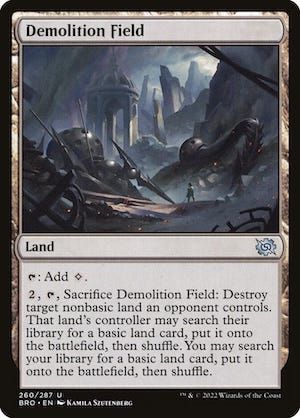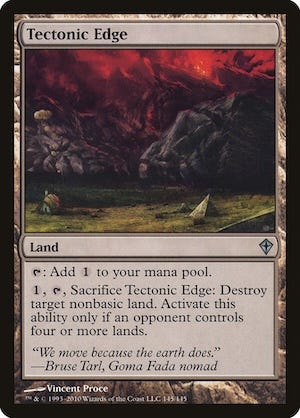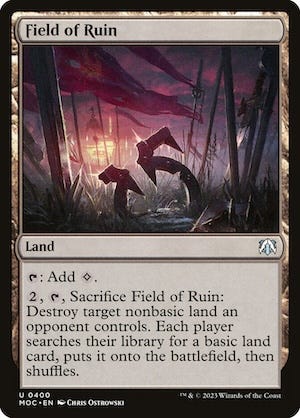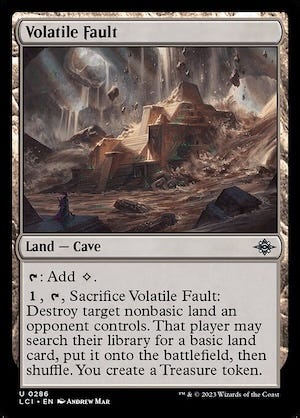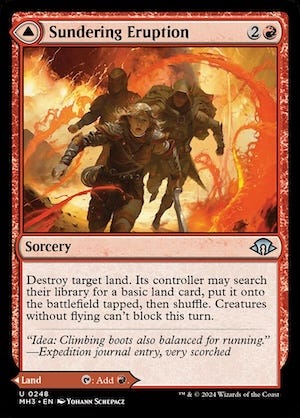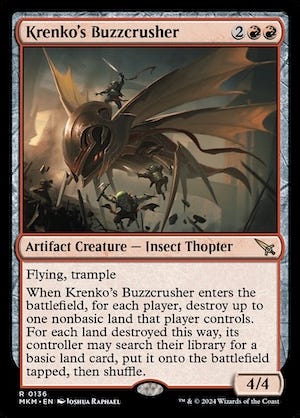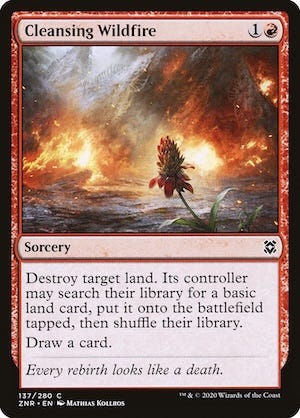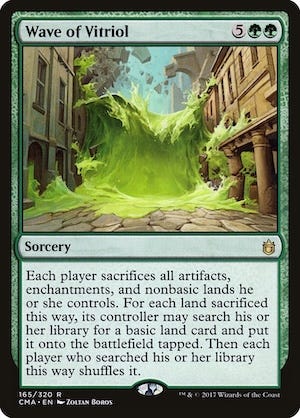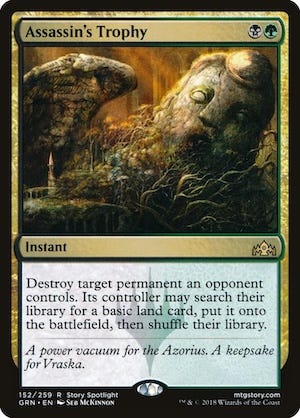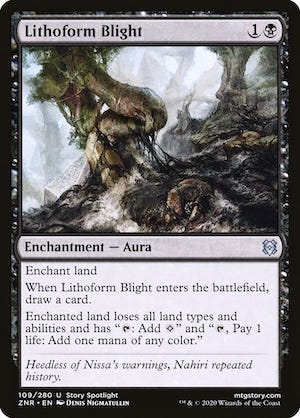Demolition Field
Or "How to Destroy More Lands" (And Not Make People Upset)
I think that Demolition Field is the “gold standard” for utility-land-based land removal in casual play. I’m going to talk about it. It’s my publication I’ll write what I want to (and when I want to, if anyone was about to comment about how long it’s been since my last article).
This card, originally printed in Brothers’ War, shows up in just about 3% of decks on EDHREC (at time of writing). I think that it should be in way more.
Historical Iterations
Let’s start out with he elephant in the room, the card that most people are familiar with, the card whose name is so well known it has become synonymous with the idea of “a land that destroys other lands.” Coming in from the long-gone set of Antiquities, the reigning champ of utility-land land-removal:
This is the most efficient utility land for simply getting rid of another land. If someone has one of the most problematic lands in the game, you can simply play Strip Mine and immediately remove it. It effectively only costs one mana (the opportunity cost of tapping it to sacrifice it, when you could’ve tapped it for mana instead), and it gets the job done. This land is the absolute best if your playgroup can stomach the power of its effect, and if you only care about winning… you’re likely to already be running this.
However, it has a few problems. When our glorious leaders at WotC identify a design problem or negative play pattern, they usually try to fix it by introducing new iterations of the problematic card that keep the necessary parts of the effect but make it less problematic. The problem with Strip Mine is that it’s just too efficient, and giving up a land drop to set an opponent a land drop behind is not only pretty effective in 1v1 formats, but gets put over the edge with that pesky artifact called Crucible of Worlds. This efficiency has made many Magic: the Gathering™ players suffer from this negative play pattern over the years… so the next thing they did to try to balance the effect was introducing some sort of cost.
Tectonic Edge came to us in Worldwake and added three key restrictions. Firstly, it could only destroy nonbasic lands (something that we saw a hint of in Tempest). This prevented people from using it to completely clear someone’s board of lands, since they’d presumably have a few basics laying around. Secondly, as a failsafe for if your opponent wasn’t carrying any basics, you can “activate only if an opponent controls four or more lands.” Finally, they gave activating the sacrifice ability a mana cost. This meant the instead of effectively costing 1 mana, now it effectively costed 2 mana.
This iteration fixed a few issues, but it wasn’t perfect… and with the reprinting of Tectonic Edge in C14, some of those flaws came to light. Namely, the way that it interacts with a multiplayer format. In 1v1, both players lose a land and remain on equal footing with each other… but in a 4 player free for all, the player that got their land removed and the player that activated Tectonic Edge both end up feeling behind. They both lost a land, but the other two players did not lose anything. This was made worse by commander’s unusually long game length and durdley nature: for each turn that passes after the land was sacrificed, each of the involved players lose 1 more effective mana from the land they could’ve had. In a faster paced version of EDH, like cEDH, where turn counts don’t go that long… it doesn’t matter that much. But in an average “casual” game, where the game can last anywhere from 8 to ∞ turns, the amount of mana lost adds up.
To fix this issue, WotC asked themselves an important question that ushered in a new era of land removal: “What if the player didn’t actually have to lose a land?”
Although it was first experimented with in Dissension, the thought process of “let’s give the people involved some mana to compensate for what they lost” (I dub it “friendly land removal”) was quickly hitting the mainstream… and for good reason: no one enjoys being a mana behind for the rest of the game, especially if they’re strapped in for a long game. Of course, Field of Ruin re-introduces that downside under a different guise. The two involved players get lands to replace what they lost, but they are still a land behind the other two players since they are allowed to get lands from their decks for free. One niche upside of this card is that it forces opponents to search their library (even if they “fail to find”), and there’s at least a few commanders that care about that (I’m looking at you, Obby).
The Gold Standard
After a little bit of iteration, Wizards struck gold. They don’t print too many cards that are specifically made to destroy land without including a “the owner may fetch a basic” anymore… and for good reason: the design works at giving players tools to answer problem lands, while eliminating the negative play pattern of setting people back on their land count. Let’s go back to our pride and joy…
This is a fine utility land. It’s similar to some of the others that we’ve mentioned because it only hits nonbasic, and then it lets both players who lost a land (the player who sacrificed the field AND the player whose land got destroyed) find basic lands to replace them. Unlike Field of Ruin, it doesn’t give the other two players free ramp. At first glance, the effective mana cost of this effect is 3 mana (2 mana to activate, and 1 “opportunity cost” mana from having to tap itself)… but upon closer inspection, since it finds you an untapped basic land which you can then tap for mana, you effectively get refunded one of the mana, and the actual effective mana cost of this effect is 2, which puts it on-par with Tectonic Edge’s mana efficiency.
There are only 17 lands that fill this utility role of removing lands and only a couple of them are more efficient than that… but few of them offer the long term value that Demolition Field offers you.
Volatile Fault, for example beats Demolition Field in mana efficiency. It costs 1 to activate, plus you have to tap it (effectively costing you 1 more mana), but you get a treasure back… that’s an effective mana cost of 1! This card is friendly enough to let your opponent get a replacement land, but you don’t get a replacement land yourself.
This means that each turn after activation, you could’ve had one more mana if you got a replacement land. For the rest of the game, you can add that one mana you could’ve produced if you used Demolition Field and got a basic instead of a treasure to the effective cost of activating this card. On the turn after activating Volatile Fault, you have broken even with Demo Field at an effective cost of 2… and if you live two turns after activation, you’ve now effectively sunk more mana into this effect than the amount than the effective cost of Demolition Field.
Tips & Tricks
Alright, so you’re sold on running Demolition Field? Here are some quick notes.
Awesome in landfall: This is sort of a cheap budget fetchland that happens to have the upside of answering problem lands. Gets you two landfall triggers in the same turn, and works well with Crucible.
Great for Brainstorm: Again, sort of a budget fetchland. Brainstorm is a bit rare in this format, but if you happen to have one, this will shuffle away your unwanted cards just like a fetchland… but it’s a bit easier to match the timing than with a fetchland, since you can use it for mana until you cast Brainstorm, where as a fetch will likely feel uncomfortable wilting on the field.
Unlike Field of Ruin, this doesn’t force people to shuffle or even affect all your opponents… but if you have a smaller effect when people search or get lands such as Polluted Bonds, River Song, or even Psychic Surgery… you may be able to get an extra trigger as people “tolerate” the small amount of damage for the sake of keeping their land count up.
Demolition Field searches for a basic land (like Terramorphic Expanse), and doesn’t care about basic land types. This can be a downside, since you can’t find your fetches… but it is also a benefit since you can run it in an Eldrazi deck and find your Wastes.
More Land Destruction
As I mentioned, WotC realized that “just destroying lands and setting people back” is not a positive play pattern and they have been trying to avoid it in future designs. They’ve increasingly printed cards that answer lands (and give basics) and reduced printing cards that just destroy lands outright (and often put them at fairly restrictive effective costs). If you want to endorse WotC in embracing this “more positive play pattern,” but you find that there’s lands in your playgroup that you simply MUST remove, here are some simply awesome cards:
This card just does all the things. It’s “friendly land removal,” it provides your whole board with pseudo-evasion, and if you don’t need it you can just play it as a land. I typically try to run around 3 MDFC lands per deck, and if your deck cares about combat but isn’t already jam-packed with fliers, I think this easily fits a slot.
Everyone loves lands that have other effects… since you can run more lands and get mana screwed less, but then simultaneously use those lands for their other effects and get flooded less. Boseiju hits so many types of cards, and is just good. Everyone knows it’s good, and that’s why it’s so expensive. Moving on.
This card really scales with the multiplayer nature of the format, and lets you take out more than one problem land at a time. It’s also a decently sized creature with frample (flying + trample). What’s more, many of these cards restrict you to only hitting lands opponents control (to prevent you from doubling up on it and crazy landfall, I guess?), but this one lets you hit everyone else’s stuff AND one of your own things. A great solution if your commander has been trapped in a celestial body.
I would not call this card exciting, but it’s to the point and gets the job done. A small cantrip like this fits well in any red-inclusive spellslinger-based builds… and it also doesn’t prevent you from hitting your own stuff, allowing it to work well in landfall decks, especially ones that feature land recursion as one of its paths to get landfall triggers.
A nuclear option and a great time in green. I love how this card punishes players for being too heavy into non-basics, and helps players who are running more basics stay involved with people who have fancier or more action-packed mana bases. It also removes all artifacts and enchantments, as well, making it effectively a “board wipe for everything that isn’t a creature.”
I think that everyone knows this card is pretty efficient by now. Destroying any permanent type is bonkers good, but it sadly does get the opponent a land even if you destroyed a non-land of theirs. It’s a bit of a downside, but people still run Path to Exile due to its efficiency.
Ok, it’s not technically “land destruction,” but it does answer problem lands by removing their types and abilities… while having the “friendly upside” of allowing them to still tap it for mana as if it were a Wastes (or a Mana Confluence). It even cantrips! Shoutouts to the cards like Imprisoned in the Moon and Song of Dryads which can turn any trouble land into a less problematic land. I love Blood Sun in this category, but advise against moving to the dark side and reaching for Blood Moon (due to its ability tends to mess with people’s ability to produce mana).
“I’ll LITERALLY pay you to be less mean”
~MarRo, while tacking “draw a card” onto cards like Blood Sun, probably
Curtain Call
I think it’s time that I draw this article to a close. A lot of the cards I mentioned require you to be in specific colors (in particular, gruul is good at removing lands), but Demolition Field can go in any deck. As far as I’m concerned, it should be a staple utility land that virtually every deck runs, giving people at least one tool to answer problematic lands in a “friendly” way.
As a declaimer, I am really not a huge fan of having my lands destroyed (when they’re not replaced). I totally accept it is part of the game, and don’t blame players for using the tools they have, but I think that WotC is right to shift gears towards these more “friendly” answers, so I’m a big advocate of players running these more friendly answers when possible (if you couldn’t tell by me advocating for it right now). For another article where I talk about a play pattern I think works well in 1v1 but doesn’t translate well to multiplayer, check out my article on combos: I don't like combos. Here's why.
I hope at least one person read this article and decided to run Demolition Field over other, more overrated lands (for my article about Reliquary Tower, click here).


